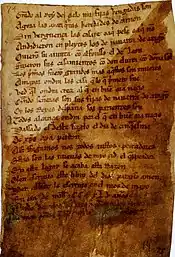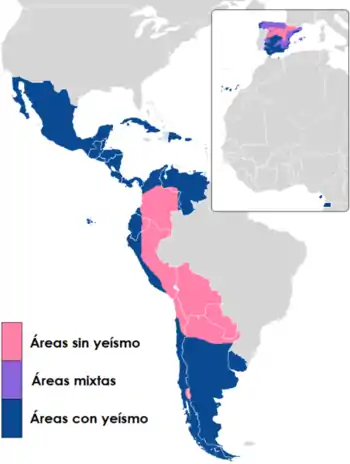Yeísmo
Yeísmo (Spanish pronunciation: [ɟʝeˈizmo]) (literally "Y-ism") is a distinctive feature of certain languages, many dialects of the Spanish language in particular. This feature is characterized by the loss of the traditional palatal lateral approximant phoneme [ʎ] (![]() listen) (written ⟨ll⟩) and its merger into the phoneme [ʝ] (
listen) (written ⟨ll⟩) and its merger into the phoneme [ʝ] (![]() listen) (written ⟨y⟩), usually realized as a palatal approximant or affricate. It is an example of delateralization.
listen) (written ⟨y⟩), usually realized as a palatal approximant or affricate. It is an example of delateralization.
| Spanish language |
|---|
 |
| Overview |
| History |
| Grammar |
| Dialects |
| Dialectology |
| Interlanguages |
| Teaching |
In other words, ⟨ll⟩ and ⟨y⟩ represent the same sound [ʝ] (![]() listen) when yeísmo is present. The term yeísmo comes from the Spanish name of the letter ⟨y⟩ (ye[1]). Now, over 90% of Spanish dialects exhibit this phonemic merger.[2] Similar mergers exist in other languages, such as French, Italian, Hungarian, Catalan, Basque, Portuguese or Galician, with different social considerations.
listen) when yeísmo is present. The term yeísmo comes from the Spanish name of the letter ⟨y⟩ (ye[1]). Now, over 90% of Spanish dialects exhibit this phonemic merger.[2] Similar mergers exist in other languages, such as French, Italian, Hungarian, Catalan, Basque, Portuguese or Galician, with different social considerations.
Occasionally, the term lleísmo (pronounced [ʎeˈizmo]) has been used to refer to the maintenance of the phonemic distinction between /ʝ/ (spelled "y") and /ʎ/ (spelled "ll").[3][4][5]
Pronunciation

Most dialects that merge the two sounds represented by ⟨ll⟩ and ⟨y⟩ realize the remaining sound as a voiced palatal fricative [ʝ] (![]() listen), which is similar to the ⟨y⟩ in English your, but with the vocal chords vibrated. However, it sometimes becomes a voiced palatal affricate [ɟʝ] (
listen), which is similar to the ⟨y⟩ in English your, but with the vocal chords vibrated. However, it sometimes becomes a voiced palatal affricate [ɟʝ] (![]() listen), sounding somewhat like ⟨j⟩ in English jar, especially when appearing after /n/ or /l/ or at the beginning of a word. For example, relleno is pronounced [reˈʝeno] and conllevar is pronounced [koɲɟ͡ʝeˈβaɾ] or [koɲdʒeˈβaɾ].
listen), sounding somewhat like ⟨j⟩ in English jar, especially when appearing after /n/ or /l/ or at the beginning of a word. For example, relleno is pronounced [reˈʝeno] and conllevar is pronounced [koɲɟ͡ʝeˈβaɾ] or [koɲdʒeˈβaɾ].
Zheísmo and sheísmo
In most of Argentina and Uruguay, the merged sound is pronounced as a sibilant [ʒ];[6] this is referred to as zheísmo. In Buenos Aires, the sound [ʒ] has recently been devoiced to [ʃ] (sheísmo) among younger speakers.[7]
Rioplatense does not, however, use the sibilant sound for word-initial /i̯/ (spelt hi- + vowel). Therefore hierro [ˈjero] is distinct from yerro [ˈʒero]. These two words are merged in most other varieties of Spanish.
The same shift from [ʎ] to [ʒ] to [ʃ] (to modern [x]) historically occurred in the development of Old Spanish; this accounts for such pairings as Spanish mujer vs Portuguese mulher, ojo vs olho, hija vs filha and so on.
Extension of yeísmo
Currently, the highlands of Colombia are shifting to yeísmo with older people being the only keeping the distinction, which is completely lost in people born in the 1980s onwards.
The distinction between /ʝ/ and /ʎ/ remains in the Philippines, Ecuadorian highlands, Andean Peru, Paraguay, Bolivia, and the northeastern portions of Argentina that border with Paraguay. [8] The distinction is more common in areas with a common bilingualism with indigenous languages, such as Aymara, Quechua, and Guaraní.[9] In Spain, most of the northern half of the country and several areas in the south used to retain the distinction, but yeísmo has spread throughout the country, and the distinction is now lost in most of Spain, particularly outside areas with linguistic contact with Catalan and Basque.[10]
Minimal pairs
Yeísmo produces homophony in a number of cases. For example, the following word pairs sound the same to speakers of dialects with yeísmo, but they would be minimal pairs in regions with distinction:
- haya ("beech tree" / "that there be") ~ halla ("s/he finds")
- cayó ("s/he fell") ~ calló ("s/he became silent")
- hoya ("pit, hole") ~ olla ("pot")
- baya ("berry") / vaya ("that he go") ~ valla ("fence")
The relatively low frequency of both /ʝ/ and /ʎ/ makes confusion unlikely. However, orthographic mistakes are common (for example, writing llendo instead of yendo). A notable case is the name of the island of Mallorca: since Mallorcans tend to pronounce intervocalic /ʎ/ as /j/, central Catalan scribes assumed the authentic (and correct) name Maiorca was another case of this and hypercorrected it to Mallorca. This new form ended up becoming the usual pronunciation, even for native Mallorcans.[11]
Similar phenomena in other languages
Romance languages
- Standard Portuguese distinguishes /ʎ/, /j/ and /lj/. Many speakers merge /ʎ/ and /lj/, making olho and óleo both /ˈɔʎu/. Some speakers, mainly of the Caipira dialect of Brazil, merge /ʎ/ and /j/, making telha and teia both /ˈtejɐ/. Some Caipira speakers distinguish etymological /ʎ/ and /lj/, pronouncing olho /ˈɔju/ and óleo /ˈɔʎu/.
- In French, historical /ʎ/ turned into /j/, but the spelling ⟨ill⟩ was preserved, hence briller ([bʁi.je], originally [bʁi.ʎe]), Versailles ([vɛʁ.sɑj], originally [vɛʁ.sɑʎ]).
- The Romanesco dialect of Italian pronounces standard Italian /ʎ/ as /j/.
See also
- History of the Spanish language
- List of phonetics topics
- Phonological history of Spanish coronal fricatives (distinción, seseo and ceceo)
References
- "La "i griega" se llamará "ye"" Cuba Debate. 2010-11-05. Retrieved 25 November 2010.
- Coloma (2011), p. 103.
- Álvarez Menéndez (2005), p. 104.
- Schwegler, Kempff & Ameal-Guerra (2009), p. 399.
- Travis (2009), p. 76.
- Martínez-Celdrán, Fernández-Planas & Carrera-Sabaté (2003), p. 258.
- Lipski (1994), p. 170.
- Coloma (2011), p. 95.
- Lapesa, Rafael. "El español de América" (in Spanish). Cultural Antonio de Nebrija.
- Coloma (2011), pp. 110–111.
- "Mallorca (1.)", Diccionari català-valencià-balear, Institut d'Estudis Catalans
Bibliography
- Álvarez Menéndez, Alfredo I (2005), Hablar en español: la cortesía verbal, la pronunciación estándar del español, las formas de expresión oral, Universidad de Oviedo
- Coloma, German (2011), "Valoración socioeconómica de los rasgos fonéticos dialectales de la lengua española.", Lexis, 35 (1): 91–118
- Lipski, John (1994), Latin American Spanish, New York: Longman Publishing
- Martínez-Celdrán, Eugenio; Fernández-Planas, Ana Ma.; Carrera-Sabaté, Josefina (2003), "Castilian Spanish" (PDF), Journal of the International Phonetic Association, 33 (2): 255–259, doi:10.1017/S0025100303001373
- Navarro, Tomás (1964), "Nuevos datos sobre el yeísmo en España" (PDF), Thesavrvs: Boletín del Instituto Caro y Cuervo, 19 (1): 1–117
- Torreblanca, Máximo (1974), "Estado actual del lleísmo y de la h aspirada en el noroeste de la provincia de Toledo", Revista de dialectología y tradiciones populares, 30 (1–2): 77–90
- Schwegler, Armin; Kempff, Juergen; Ameal-Guerra, Ana (2009), Fonética y fonología españolas, John Wiley & Sons, ISBN 978-0470421925
- Travis, Catherine E. (2009), Introducción a la lingüística hispánica, Cambridge University Press
Further reading
- Pharies, David (2007). A Brief History of the Spanish Language. University of Chicago Press. ISBN 978-0-226-66683-9.